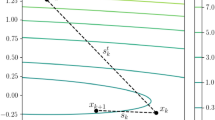This paper is devoted to an analysis of the rate of deep belief learning by multilayer neural networks. In designing neural networks, many authors have applied the mean field approximation (MFA) to establish that the state of neurons in hidden layers is active. To study the convergence of the MFAs, we transform the original problem to a minimization one. The object of investigation is the Barzilai–Borwein method for solving the obtained optimization problem. The essence of the two-point step size gradient method is its variable steplength. The appropriate steplength depends on the objective functional. Original steplengths are obtained and compared with the classical steplength. Sufficient conditions for existence and uniqueness of the weak solution are established. A rigorous proof of the convergence theorem is presented. Various tests with different kinds of weight matrices are discussed.
Similar content being viewed by others
References
G. E. Hinton, A. Krizhevsky, N. Srivastava, I. Sutskever, and R. Salakhutdinov, “Dropout: a simple way to prevent neural networks from overfitting,” J. Mach. Learn. Res., 15, 1929–1958 (2014).
H. K. Jabbar and R. Z. Khan, “Methods to avoid over-fitting and under-fitting in supervised machine learning (comparative study),” in: Computer Science, Communication & Instrumentation Devices, Editors: J. Stephen, H. Rohil, and S. Vasavi, (2015), pp. 163–172.
R. Salakhutdinov and G. E. Hinton, “Deep Boltzmann Machines,” Proc. Conf. Artif. Intel. Stat. (AISTATS 2009), 448–455 (2009).
L. Bottou, F. E. Curtis, and Jorge Nocedal, “Optimization methods for large-scale machine learning,” SIAM Rev., 60, 2, 223–311 (2018).
R. Salakhutdinov, “Learning Deep Boltzmann Machines using adaptive MCMC,” Proc. 27th Int. Conf. Mach. Lear., Haifa, Israel, 943–950 (2010).
R. Salakhutdinov and H. Larochelle, “Efficient learning of Deep Boltzmann Machines,” J. Mach. Learn. Res., 9, 693–700 (2010).
G. Hinton and R. Salakhutdinov, “An efficient learning procedure for deep Boltzmann machines,” Neural Comput.,24, 8, 1967–2006 (2012).
K. Cho, T. Raiko, A. Ilin, and J. Karhunen, “A two-stage pretraining algorithm for Deep Boltzmann Machines,” Artif. Neural Netw. Mach. Learn. (ICANN), 8131, 106-113 (2013).
K. Cho, T. Raiko, and A. Ilin, “Gaussian–Bernoulli Deep Boltzmann Machine,” IEEE Int. Joint Conf. Neural Netw., Dallas, Texas, USA, 1–7 (2013).
A. Dremeau, “Boltzmann machine and mean-field approximation for structured sparse decompositions,” IEEE Trans Signal Process., 60, 7, 3425–3438 (2012).
N. Srivastava and R. Salakhutdinov, “Multimodal learning with Deep Boltzmann Machines,” J. Mach. Learn. Res., 15, 2949–2980 (2014).
J. Barzilai and J. M. Borwein, “Two-point step size gradient methods,” IMA J. Numer. Anal., 8, 1, 141–148 (1988).
E. G. Birgin, J. M. Martínez, and M. Raydan, “Spectral projected gradient methods: review and perspectives,” J. Stat. Softw., 60, 3, 1–21 (2014).
M. Raydan, “On the Barzilai and Borwein choice of steplength for the gradient method,” IMA J. Numer. Anal., 13, 3, 321–326 (1993).
T. D. Todorov, “Nonlocal problem for a general second-order elliptic operator,” Comput. Math. Appl., 69, 5, 411–422 (2015).
D. Wei, “Finite element approximations of solutions to p-harmonic equation with Dirichlet data,” Numert. Func. Anal. Optim., 10(11&12), 1235–1251 (1989).
T. D. Todorov, “Dirichlet problem for a nonlocal p-Laplacian elliptic equation,” Comput. Math. Appl.,76, 6, 1261–1274 (2018).
A. Zhang, J. Zhu, and B. Zhang, “Max-margin infinite hidden Markov models,” Proc. 31st Int. Conf. Mach. Learn. (PMLR), 32, 1, 315–323 (2014).
G. S. Tsanev, “Deep multiconnected Boltzmann machine for classification,” Amer. J. Eng. Res., 6, 5, 186–194 (2017).
Author information
Authors and Affiliations
Corresponding author
Rights and permissions
About this article
Cite this article
Todorov, T.D., Tsanev, G.S. Two-Point Step Size Gradient Method for Solving a Deep Learning Problem. Comput Math Model 30, 427–438 (2019). https://doi.org/10.1007/s10598-019-09468-5
Published:
Issue Date:
DOI: https://doi.org/10.1007/s10598-019-09468-5




